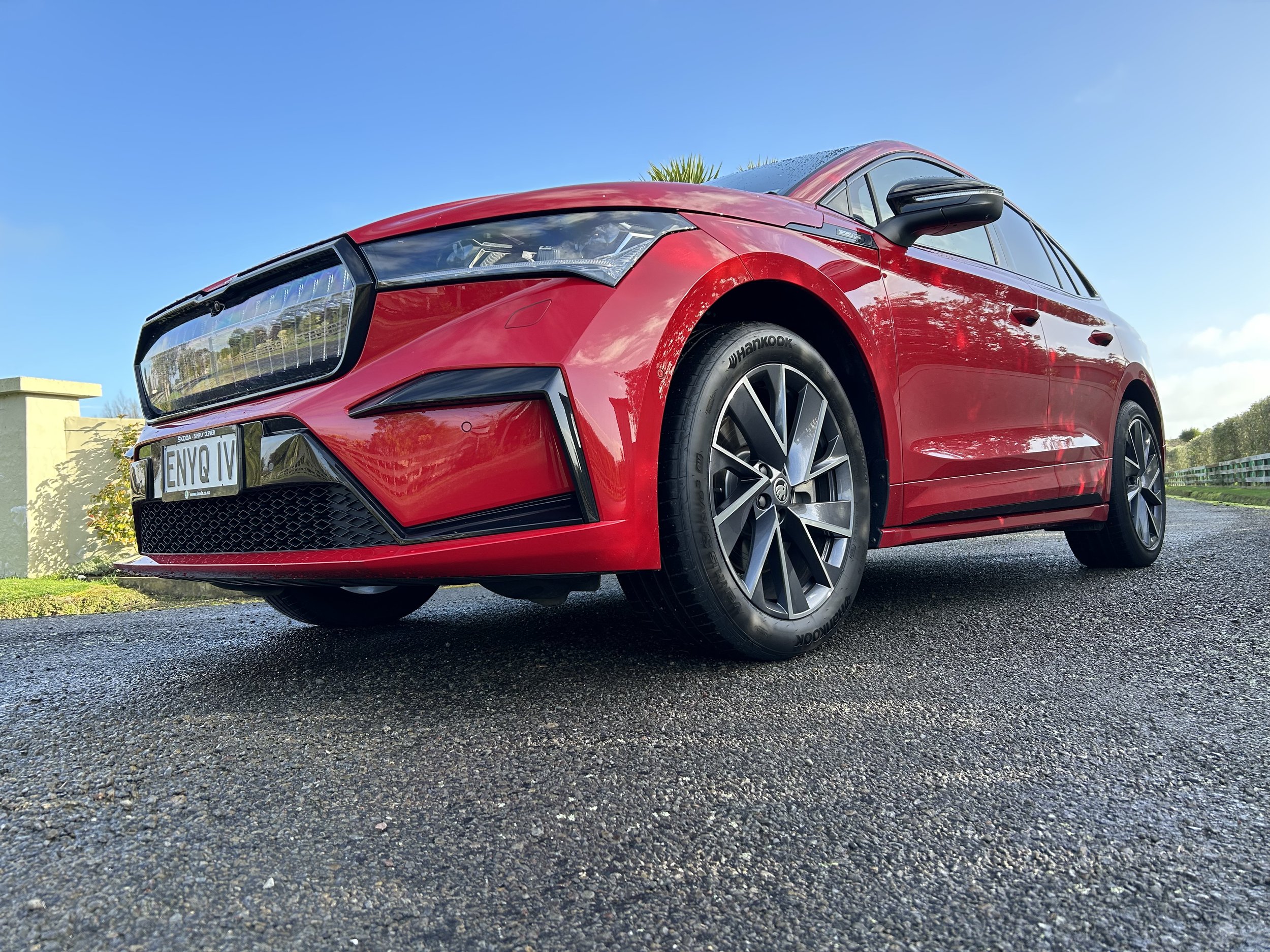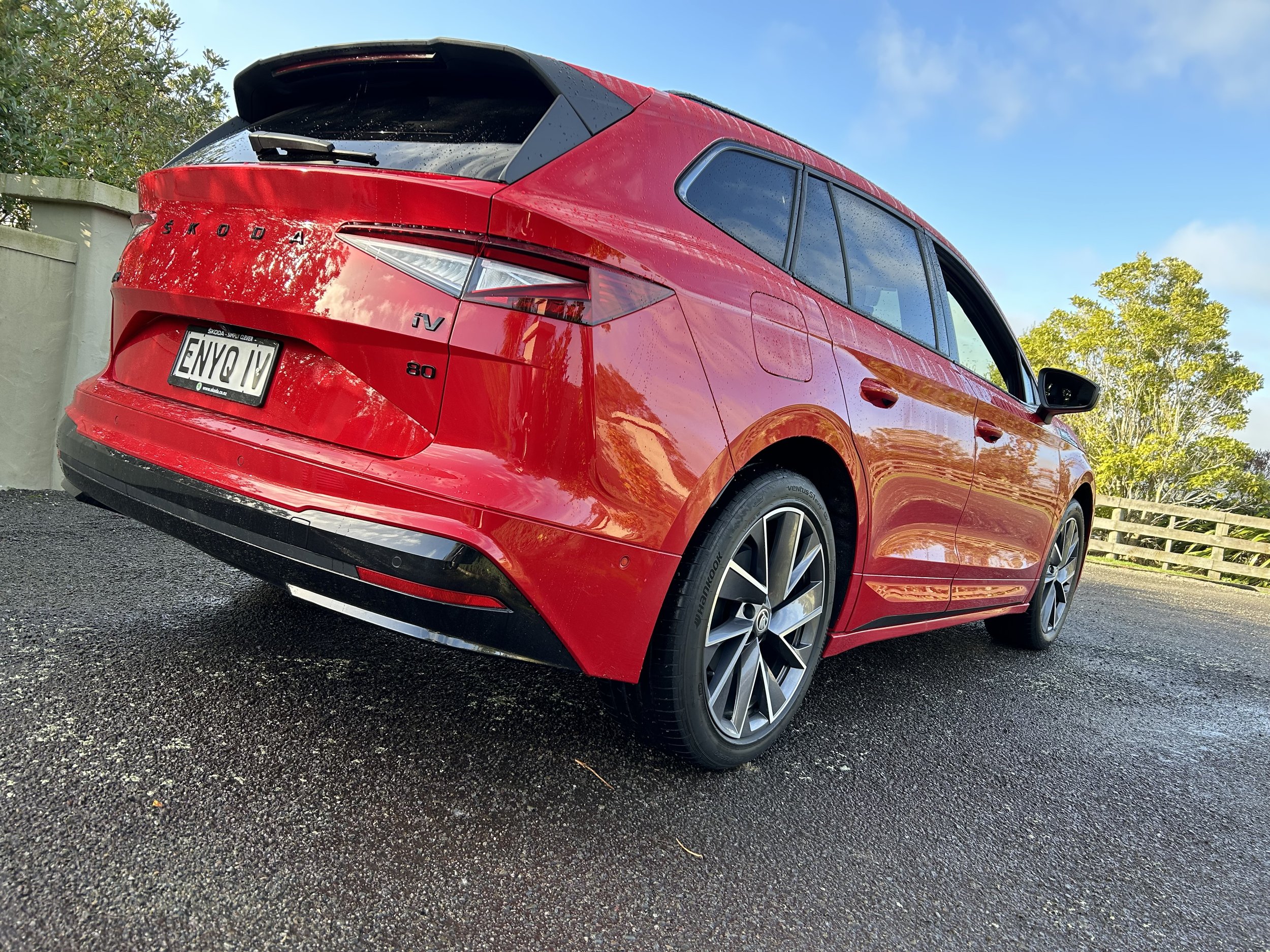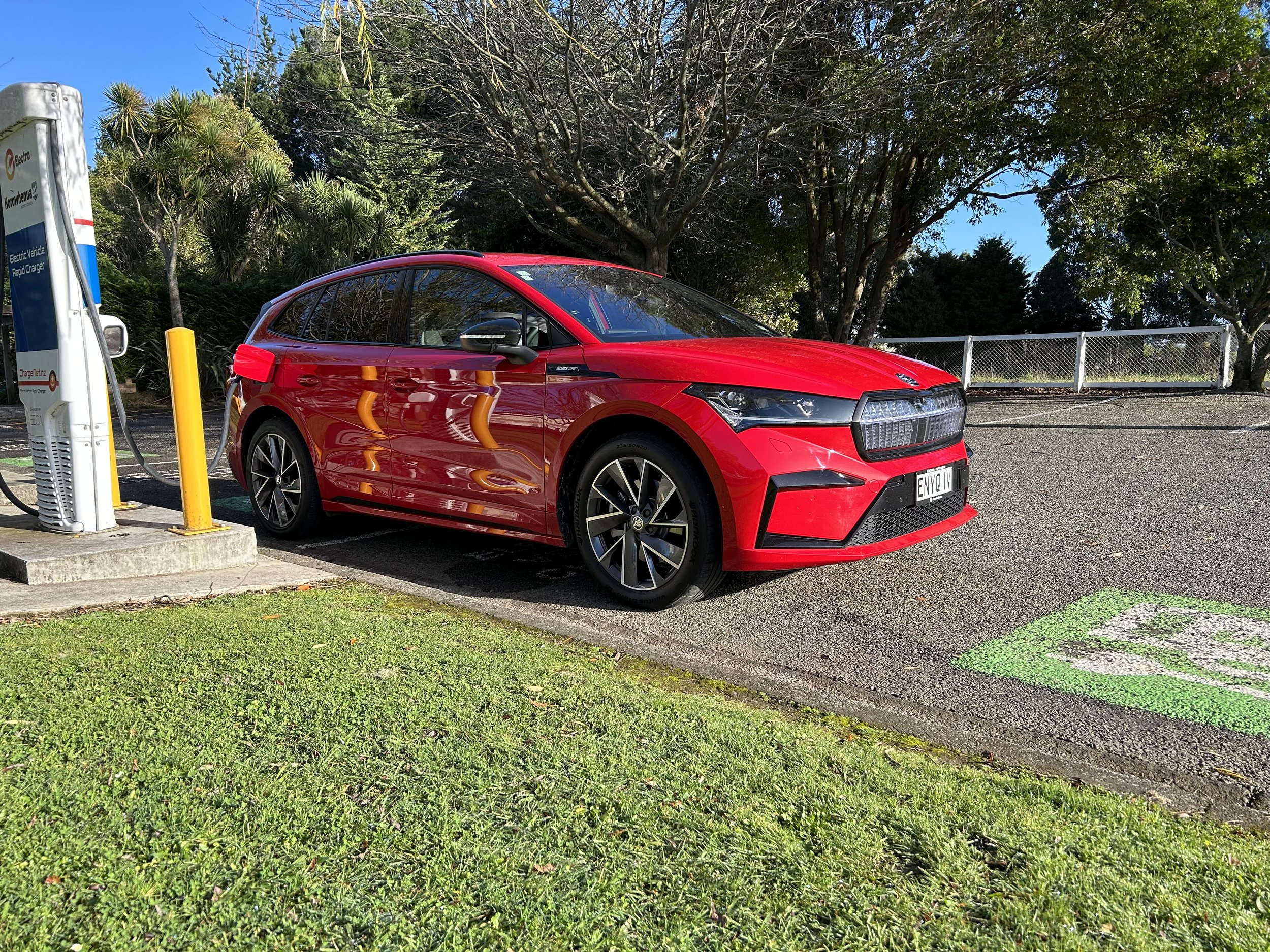Skoda Enyaq iV Sportline roadtest review: Fewer dollars, more sense
/A sensible pricing realignment restores the top-flight version of this crucial electric car to top of the logic list.
Price: $84,990.
Drivetrain: Permanent magnet synchronous motor, 77kWh lithium ion battery, rear-wheel-drive, maximum power 150kW, maximum torque 310Nm; single speed transmission; energy consumption: 16.2-17.4 kWh/100km (WLTP).
Vital statistics: Length, 4649mm; width, 1879mm; height, 1621mm; wheelbase, 2765mm; 585/1710 litres luggage capacity; 235/45 R21 tyres.
We like: Family-friendly practicality; value; familiarity for Skoda faithful.
Not so much: Max spec could make rebate eligible entry car seem like a hair shirt option; low towing rating; single motor less an SUV than a big hatchback.
WHAT to make of the big ‘wow’ element, the ‘Crystal Face’, an illuminated grille that lends a unique after-dark appearance: Kinda cool or just a bit trite?
For me? The whole ‘glow show’ is okay; a frippery I can put up with. For my wife? More of a ‘meh’ moment, sorry.
Well, we’re Skoda people. You have to expect this from our kind. If asked to best describes what this brand means, expect responses salted with words like ‘practical’, ‘logical’ and ‘sensible.’
More than 130 LEDs, which illuminate 18 transparent vertical ribs and a single horizontal bar enact a 15 second welcoming/leaving animation. So clever. And yet … how much zhuzhing up can a car like this stand? Or need? We might appreciate the fun. But we’ll also wonder about the cost of replacement or repair. Just our style, sorry.
For us, Skodas don’t to be spaceships. They just need to useful for everyday living. That’s our credo. That’s why we crow about the the brolly in the door, the ice scraper (both ticked off here) now in the boot, having transferred from the fuel flap. Useful stuff. Speaking of. Let’s discuss the torch in the boot. Or, more to the point, its absence. The suits at head office in Mlada Boleslav can expect an angry letter or two.
Still, Skoda’s are also about future looking, no more so than now, with a big leap into electric driving.
Could there ever be a bigger moment of change in this brand’s history than is represented by Enyaq? I think not.
And I’d like to think I know Skoda fairly well. I’m just starting out with my second in personal use. After four years with a owned since virtually new diesel Karoq, almost a fossil fuel doppelgänger to Enyaq in general format and look, we’ve now copped (see what I did there?) a Superb wagon: 206kW petrol, also four-wheel-drive, also pre-owned but mint, still, after 77k on the clock.
I liked my last one, I like the one I have now. And I would have loved to have had an Enyaq. Maybe next time. Even though the pricing is thankfully far more sensible now than when it first aired, this product is still out of my reach.
A pity, that. Enyaq comes in with many strengths, but the one that really stood out on test is how well it adheres to established brand principles.
The grille light show? A love it or lump it auto-activating element of the specification for the Sportline Max on test can be treated as a harmless frivolity, a light-hearted amusement. Something to remember the car by. Hardly a must-have. But don’t sweat the extravagance. All in all, Enyaq is a car whose design detailing is just as we like it. Relatively restrained.
As I write this, Enyaq playing a straight bat in respect to how it looks seems to be on trend, at least within the VW Group, where the newly-appointed head of design has just publicly decried the trend for EVs to increasingly look like something from science fiction.
Andreas Mindt’s belief that much new fare being over-styled to appeal to buyers with a technology focus, with a preponderance of similar-looking sleek designs with rounded noses that are weirdly different, is overdoing it. His view? EV buyers are the same customers who are likely to trade-in a petrol or diesel car. The industry needs to “just calm down.” Interesting.
Maybe this is a sentiment that has been subject to coffee break chat within VW-dom for ages; given it would seem to be exactly the approach that shaped Enyaq.
When asked at time of initial unveil about what he saw as this car’s design sweet spot, Oliver Stefani - in his fourth year as head of Skoda design by then - didn’t mention the Crystal Grille. Instead, he looked to the rear three-quarter, stylish yet squared. Panache and practicality. Although Skoda’s image has increasingly become smarter, sportier and sexier, functionality has to be the strongest point of differentiation.
Smart man, that Stefani. And an important man when it comes to all things MEB. Perhaps no other designer in the VW Group fold has more experience with the platform also underpinning it’s on-this-scene siblings. The VW’s ID.4 and ID.5, the Audi Q4 and Cupra Born.
In their company alone, Enyaq is sensible shoes. It works for me. And, importantly, it does seem set to support proposal that good design stands time’s test. It already has, really.
Though new here - to point where, with on-sale not set to start until September, this evaluation car is out of the Ireland-spec batch brought in to entice interest - Enyaq as we see it has been on sale in Europe for two years. It will achieve a facelift for 2024. Don’t worry; the visual changes are minor. But the drivetrain gains zap and the distributor has already said pricing will alter to reflect.
As is, Enyaq reinforces MEB is not codex for ‘Russian doll’. All the underpinnings are identical across the brands. But this body size is specific to Skoda. Not a single body part is shared with the others.
It’s bigger in the metal than photos suggest and the cab-forward proportions and long rear overhang pay dividends for those of use who are into useability. Shorter than the Superb and Octavia station wagons, it doesn’t lack of capaciousness regardless. Sense of speciousness is enhanced by the tall roof, the upright seating, the flat floor and the width. Footprint-wise, it is below Kodiaq, above Karoq. It’s a lot lower than either, but to the eye it’s still more of a ‘two-box’ SUV than its VW ID and Audi Q4 counterparts. It’s a box, almost. I like that.
It classes as an SUV, but does it deliver as one? Not really. There isn't a great deal of ground clearance and, anyway, it’s just rear-drive. So don't expect to go very far off-road in it. It’ll also only tow up to 1000kg. Treat it as a mega hatch and you’ll be happy as.
Every MEB car so far signed up for sale here has, regardless of the badge, the same formula. Single motor, 82kWh lithium-ion battery with 77kWh of usable storage, 150kW/310Nm, promising 8ish to 9-and-a-bit seconds-100kmh performance. A WLTP-tested range above 500kms.
And the same feel? Enyaq is the third MEB I’ve experienced on NZ roads, along with ID.4 and Cupra Born. All are much of a muchness for performance, which suggests at best subtle differences in calibration variances to the drivetrains. Yet there’s genuine distinctiveness in the steering feel and suspension tuning; the Spanish choice is edgy and sporty, the VW decisive but more measured … and the Skoda is? Well, Skoda-ish. Relaxed, not flashy, but solid and predictable. Comfy.
No ,really. The Max format sounds sporty: 21-inch rims, the largest offered, which fill the arches nicely and wear sporty rubber, plus adaptive dampers as part of the Drive Sport Package Plus.
Everything points to a certain aptitude. Sure enough, the tyres have loads of grip and the car is assured when pushed, but there’s nothing about the car that asks it to be driven that hard. With DCC, in fact, it seemed more useful to have it in the comfort mode rather than the firmer-edged alternate. Like my Superb.
Some of this is due to Enyaq’s size and, unsurprisingly, given there’s a substantial battery mounted skateboard-style under the floor, the sense of weight. It tips the scales at 2090kg (including driver).
With the battery set way down low, it feels very planted and, fair dues, it also feels quicker than the 8.3 seconds 0-100kmh time suggests. Roll-on acceleration from urban speeds is fine;.if you make full use of its torque when kicking off and also turning, the rears will chirp before the traction control kicks in. But, overall, it nonetheless glides through life.
That suits, as refinement is excellent. There’s little wind noise, even at higher speeds, and while coarse chip will elevate road road, it’s not intolerable. Plus, there’s barely an electric motor whine.
As with most EVs, top speed is electronically capped, here to 160kmh. Different drive modes alter characteristics in the usual way, changing the steering feel and whether it recuperates energy when you lift off the accelerator or 'sails' unimpeded. Sport mode isn’t demanded, but doesn’t go unnoticed either.
Manufacturer claimed range is likely beyond reach here; just the resistance from coarse chip alone takes the edge off. But I’d be confident of seeing around 450kms from a charge once it’s suited to your ways. It calculates your maximum range based on your driving history, so anyone with a gentle right foot will nudge it up over time. My example had a long road to redemption, having suffered a succession of press testers.
General battery regeneration can be controlled using paddles, three levels to choose from, with a ‘B’ mode on the gear selector itself for most assertive feel. Touch the accelerator and it’s back to automatic mode.
In Europe, the car can use its mapping data to automatically start slowing and recovering energy as it approaches intersections or roundabouts. This function comes to some VW Group cars here (the Q5 PHEV for instance), but whether it’ll feature on MEB product remains unclear. It wasn’t operating on the test car, as its maps were seeking Irish roads. It also identified a local radio as transmitting from Slovenia.
Even though it has a touch of gentle giant about it, urban use is no hindrance to Enyaq. The parking sensors and reversing camera at this spec level are very worthwhile, of course, but equally appreciated is the excellent visibility and manoeuvrability; the turning circle of 9.3 metres is remarkably tight for such a large vehicle.
Charging is easy and straightforward. If you can find a hyper charger that is operating at promised pace, Enyaq will be a short-term user. An 80 percent 'fill' from 40 minutes at a 125kW or stronger DC-powered station is promised. Skoda has a tie with Chargenet, but only to point where cars come with a RFID dongle. Owners need to set up an account. They’ve also sorted a wallbox. It has an onboard 11kW charging unit.
Max delivers with lane keeping, collision warning with autonomous braking and adaptive cruise control. The first and second can sometimes be too keen, while the ACC is a touch weird, with more reluctance to speed up after you’ve pulled across a lane to overtake than I experience in my previous and current cars. It seemed to be confused by vehicles in the adjacent lane.
Slip into the cabin and you’re finding lots of similarity with Skoda's other models, which might surprise given so much change to the fundamentals.
The usual instrument displays are replaced by a small – surprisingly so, actually - digital display ahead of the steering wheel while a centrally mounted freestanding 13-inch touchscreen sits atop the dashboard, with impressive clarity and resolution. There’s no gear stick as such - it’s not needed for electric so instead gets a small toggle switch. Likewise the park brake is electronic.
Even so, the whole ' simply clever' mantra pervades. There’s no lack of places to put things. Most useful is the sizeable centre console between the front occupants, holding bins and trays all the way down to the floor.
Two phone trays in the centre console, angled away from the driver to avoid distraction, will wirelessly charge your device, though in this car my phone had be very accurately sited to achieve this. In respect to phones, the Apple CarPlay function doesn’t always connect, but that seems to happen with almost every new car, so Skoda is no worse than the competition. You can also tether via the USB-C ports; two sited up front, two more for passengers in the back.
Using a phone for sat nav guidance is a ‘must-do’ because the native system has to be adjusted for NZ. Successful resolution of that challenge will likely make it smarter in destination plotting, achieve speed sign recognition plus the display will deliver in augmented reality, meaning it’ll project moving arrows to appear in front of the windscreen to help make direction changes easier to understand.
The touchscreen was good to use; the display is coherent and, because it sites nice and high on the dash, is within easy reach. The neat little wing under the screen is useful to keep your hand steady when you’re punching prompts while driving. Not everything is screen-operated; Skoda gets a thumbs up for providing physical controls as shortcut functions to driving modes, parking assist and the climate control.
In respect to the latter: When you press the “clima” button, the screen automatically goes to the smart climate functions, like “cool my feet” or “warm my hands”. If you just want to do normal things like turn the air-con on or off, or adjust where the air is coming from, you’ve got to press another button to get to standard temperature control. A bit of a faff.
About the kit. The big allure with Enyaq is that the base level now achieves a rebate, but you need be aware that the Sportline Max that’s sits almost $5000 above the cut-off for the Government cheque has significantly more treats.
If dollar saving is not the absolute, it’ll be hard to not like the Max fit out. It is a very comfortable, decently refined and extremely well-provisioned vehicle that, regardless of not being in line for a rebate, still seems strong value at its new price.
There’s nothing in it I would not absolutely want, save perhaps the panoramic sunroof. Though that wouldn’t be a deal-breaker. The Sportline treatment is something the designers clearly put a lot of attention into. The car looks good with it; the type sits a bit lower and sill panels, left black on lower-spec fare, are in body colour, to enhance this hunkered air. Gloss black highlights proliferate and with this trim you gain LED Matrix headlights, that can dynamically alter the high beam light without dazzling others.
Sportline delivers a thick-rimmed three-spoke steering wheel, carbon fibre effect on the leading edge of the winged dashboard fascia and front seats so heavily bolstered they could almost pass for competition chairs, with massage function and full electric adjust. They and the outboard rears are heated, too. It has a premium stereo tri-zone air conditioning, rear window blinds, electric tailgate. In short, it feels like a really smart, plush car inside. Will we say the same about the base one?
Any Enyaq will surely win kudos for roominess. There is plenty of rear passenger space with good knee- and headroom, even with the panoramic glass fitted, is fine. Boot space is a generous 585 litres (a little more than an ID.4) and when the rear seats are folded down, storage space swells to 1710 litres.
Could it have offered even more? Unlike some other electric SUVs, there isn't a storage area under the bonnet, but it has a 585-litre boot with the usual clever hidden compartments, one purpose-shaped for charging cables. Enyaqs have a cubby beneath the boot floor to store the charge cable, but it’s not quite big enough to fit all the cables. Some EVs have storage under the bonnet for the same job, but while there is space for one in the Enyaq, Skoda hasn’t used it.
Skoda can push all the usual sustainability credentials. Enyaq leather is treated with olive-leaf extracts instead of chemical tannins, there’s recycled bottle plastic in the floor mats. ‘Skoda sensible’ still there; durability to withstand family punishment means a lot of hard-wearing plastics Skoda doesn’t mind you seeing.
Skoda’s rock solid status as the value-conscious brand was rudely disrupted when the original pricing strategy put this car at $97,990, so $5090 more than the base and $5000 less than the Coupe. What seemed a lemming leap policy then has thankfully been revised, with $13k across the board reduction.
The sticker it has is far more tenable, though it still has a fight as many obvious rivals beyond the entry ID.4 and ID.5 achieve rebates. I’d cite the Tesla Model Y ($76,200, 60kWh battery, 220kW/420Nm), Hyundai Ioniq 5 ($79,990, 58kWh, 125kW/350Nm) and Kia EV 6 ($76,990 58kWh and $79,990 77kWh Air derivatives, 125kW and 168kW, 350Nm both), plus the incoming Ford Mustang Mach-E (75.7kWh battery, 198kW/430Nm in entry $79,990 format). Another worth weighing the Skoda up against is the Volvo C40 Recharge P6, front drive this year and rear-drive in 2024. It has 69kWh, 170kW/330Nm and costs $85,900. Then there’s its Polestar sister ship; all the same gear, a bit cheaper.
All the same, Skoda’s first clean-sheet design for an EV is massively impressive. A great look, top-notch interior and a memorable driving experience makes it an especially solid offering. More than established brand fans will be impressed.
























